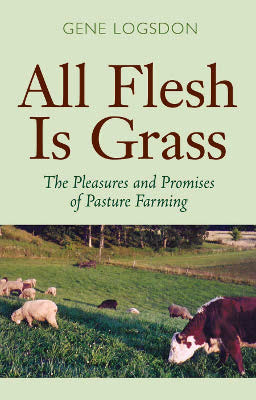
All Flesh is Grass
 Gene Logsdon's All
Flesh is Grass
doesn't quite bring rotational grazing to the backyard, but the
author's focus on people with 2 to 100 acres who are growing meat for
personal consumption makes his ideas accessible to the average
homesteader. Don't get me wrong --- the intense information in Greener
Pastures on Your Side of the Fence and in Greg
Judy's mob grazing workshop were invaluable as I
continue to plan our pasturing setup, but it's also helpful to hear
from someone farming on a much smaller scale.
Gene Logsdon's All
Flesh is Grass
doesn't quite bring rotational grazing to the backyard, but the
author's focus on people with 2 to 100 acres who are growing meat for
personal consumption makes his ideas accessible to the average
homesteader. Don't get me wrong --- the intense information in Greener
Pastures on Your Side of the Fence and in Greg
Judy's mob grazing workshop were invaluable as I
continue to plan our pasturing setup, but it's also helpful to hear
from someone farming on a much smaller scale.
What does Logsdon's
pasture setup look like? His 32 acre farm in northern Ohio has
about 15 acres devoted to pasture, on which he raises cows, sheep, and
chickens for his family. The farm is divided into seven paddocks,
each of which is about two acres in size, and he lets livestock spend
about three weeks in each area before rotating them to the next paddock
in line. (Yes, it
is suboptimal to keep your livestock in a paddock for more than six days, but sometimes the
homesteader doesn't need to reach peak efficiency if he wants to keep
his sanity.)
Most of Logsdon's
pastures are a permanent mixture of bluegrass, ryegrass, white clover,
and tall fescue. However, he also rotates a few paddocks through
annuals (and short-lived perennials) like red clover, wheat, corn,
alfalfa, timothy, and ladino clover. Using all of these pasture
plants, Logsdon is able to start his animals on pasture in late March
and keep them there until they finish eating the stockpiled
grass in January or
February. Since he plans calving and lambing around the pasture
year, selling or eating meat animals in December, he has relatively few
livestock to feed during the nonpasture month(s).
This week's lunchtime
series will walk you through Logsdon's operation in more depth. I
highly recommend his book for the firsthand information on plant
polycultures, but have to warn you that if you have little patience for
pseudoinformation, you should skip
over the anecdotes that make up the chapters on individual types of
animals. I got bogged down in the sheep chapter for about three
months before plodding on through to the intriguing tidbits in the
second half of the book.
| This post is part of our All Flesh is Grass lunchtime series.
Read all of the entries: |
Want more in-depth information? Browse through our books.
Or explore more posts by date or by subject.
About us: Anna Hess and Mark Hamilton spent over a decade living self-sufficiently in the mountains of Virginia before moving north to start over from scratch in the foothills of Ohio. They've experimented with permaculture, no-till gardening, trailersteading, home-based microbusinesses and much more, writing about their adventures in both blogs and books.
Want to be notified when new comments are posted on this page? Click on the RSS button after you add a comment to subscribe to the comment feed, or simply check the box beside "email replies to me" while writing your comment.

Excited to learn more about this book!
~ Mitsy